Vol. 7 インタビュー ライスカンパニー
芸術による教育 ―― 新しい非営利団体のモデルと日本とのパートナーシップ
Education through Arts ―― New Model of Non-Profit Organization and Partnership with Japan
Vol.7 インタビュー ライスカンパニー、シンガポール
Interview Column 7: The RICE Company Ltd., Singapore
2015年より協議会で実施している「ASEAN諸国における企業メセナの促進とネットワーク構築に向けた調査・協議」(助成:国際交流基金アジアセンター)。本年は、この3年間交流を深めた各ASEAN文化団体へのインタビュー・コラムや、視察レポートを連載しています。
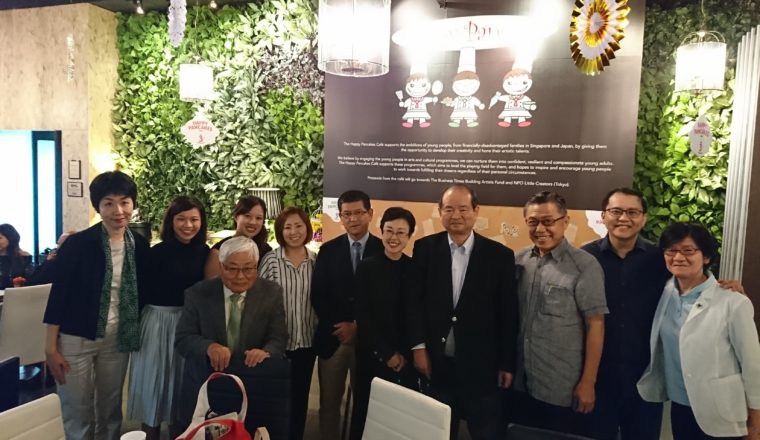
ライスカンパニーのワイイング・サム氏(部長、マーケティングコミュニケーションズ&パートナーシップス、左から4人目)、コリン・ゴー氏 (設立者・専務理事、右から2人目)、テン・テン・ダー氏(特別顧問・在シンガポールオマーン大使、右から3番目)。
カンパニーの日本のパートナーであるNPO法人リトル・クリエーターズの長谷川仰子氏(理事、右から5番目)、下倉久美氏(美術プログラム担当、左端)
The RICE Company Ltd., Ms. Wai Ying Sam (Head, Marketing Communications &Partneships, 4th from left), Mr. Colin Goh (Co-founder & CEO, 2nd from right), Mr. Teng Tan Dur (Advisor/ Ambassador, Embassy of Oman in Singapore, 3rd from right) NPO Little Creators Ms. Kyoko Hasegawa (Director, 5th from right), Ms. Kumi Shimokura (Arts Program, left)
シンガポールメセナ視察ツアー 概要はこちら
アセアン諸国における企業メセナの促進と、各国をつなぐプラットフォーム形成を目指した国際交流プロジェクトの最終年度としてシンガポール視察ツアーを実施しました。シンガポールを拠点としている多国籍企業が、現地の地域やコミュニティのために芸術文化支援を行っている先進的事例を視察し、意見交換を行いました。
Singapore Tour Outline
We conducted a Singapore tour as the final year of KMK’s (Kigyo Mecenat Kyogikai: Association for Corporate Support of the Arts) 3-year project, we have organized the continuous series of implementing research, mutual exchanges and conferences in collaboration with Southeast Asian countries, since early 2015 called ‘Research and Conference in Facilitating Corporate Mecenat Activities and Establishing a Network in ASEAN Countries’.
————————————————————————————
ライスカンパニー
民間の非営利・チャリティー団体として2014年設立。演劇や展覧会などのプロデュース、貸しスペース事業、および芸術を通じた教育プログラムを提供している。傘下には2つの組織(1つは法人・もうひとつは芸術団体)を持ち、2つの基金を運営している。http://www.therice.sg/
The Rice Company
Founded in 2014, The RICE Company Limited (TRCL) is a non-profit organization that harvests the potential of the arts and culture for the development of human lives and connecting communities locally and around the world. TRCL was incorporated on 26th of March 2014 and is a registered charity with an IPC (Institutions of a Public Character) status. They run two subsidiaries and funds to provide arts educations and experiences accessible to all young people. http://www.therice.sg/
*インタビュー対応者 | Interviewees
テン・テン・ダー(理事・在シンガポールオマーン大使)
Mr. TENG Theng Dar (Ambassador to the Sultanate of Omen,Ministry of Foreign Affairs SINGAPORE)
ワイイング・サム(部長、マーケティングコミュニケーションズ&パートナーシップス)
Ms. Sum Wai Ying (Head/Marketing Communications & Partnership, Harvesting the arts)
コリン・ゴー (CEO、ライスカンパニー/専務理事,ミレット・ホールディングス)
Mr. Colin Goh (CEO, The RICE Company Ltd/ Executive Director, Millet Holdings)
長谷川仰子(理事、リトルクリエーターズ)
Ms. Kyoko Hasegawa (Director/NPO Little Creators)
下倉久美(美術プログラム担当、リトルクリエーターズ)
Ms. Kumi Shimokura (Arts Program, NPO Little Creators)
————————————————————————————
ライスカンパニーの事業
コリン:ライスカンパニーではさまざまな事業を展開していますが、そのうちのひとつとして、芸術を通じた子どもたちの教育プログラムや、演劇・展覧会などのプロデュースを行っています。また国内に所有している5つのスペースを部分貸しし、収入を得るという貸しスペースも運営しています。だいたいこの3つが主な事業です。
Colin: The RICE Company Ltd., is involved in several businesses, one is to provide educational programs through arts for children, and to produce theatrical performances and exhibitions. Also, we own total of 5 spaces in Singapore, and they earn income by renting these spaces. Mainly these three businesses.
今日こちらにきてくださっているテンさんは、シンガポールのオマーン大使で、ライスカンパニーの特別顧問です。また、今日は私たちの日本のパートナーとのコラボレーション3周年セレモニーがあり、パートナーであるNPO法人リトルクリエーターズの長谷川さんにも来ていただいています。
This morning also I have Tang san, our Singapore Ambassador to Oman, as well as our special advisor. Because this is our 3rd year anniversary of our collaboration with our Japan partner, I invited Kyoko san to explain our partnership over 10 years.
テン:私たちは非営利の民間団体ですが、それと同時にチャリティー団体でもあります。シンガポールでは両方とも別扱いになっており、両方のステータスを同時に持つことができます。ただ、チャリティーのステータスを得るには厳しい審査があります。認可が厳しいのです。
Tang: We are non-profit private organization, but at the same time, we are the charity. In Singapore, non-profit organization and charity organization are different. We can gain both statuses, but in order to gain the status of charity, we have to go through very strict inspection. The approval is much harder.
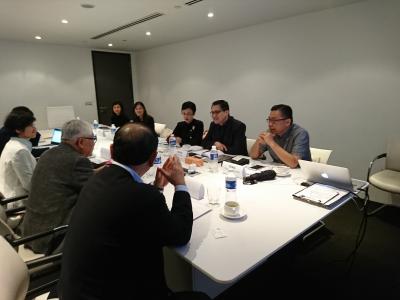
視察での意見交換 10スクエア内のオフィスにて Discussion at their office in 10 Square
ワイイング:このライスカンパニーは3つの施設で異なるプログラムをしています。ひとつが「リトル・アーツ・アカデミー」といい、小学生ぐらい(6歳から12歳まで)の子どもたちを対象にアートの教育を提供をしています。そしていま皆さんがいるのは「10スクエア」といって、13歳から19歳までの若者がアートの教育を受ける場所となっています。また、19歳を過ぎて20歳前後になると、男の子はこの国では兵役があるので22歳~23歳前後になりますが、「パビリオン」という施設で、新しくビジネスを始めたい若者たちを支援するための場所を提供しています。
Wai Ying: So RICE runs different programs providing arts education in 3 different venues; first one is Little Arts Academy between 6-12 years old. Then 10 Square, where we are now, is for 13-19 years old. After 19 years old, well boys have to serve the military in Singapore so 22-23 years old for them, we provide support for young entrepreneurs at Pavillion.
このプログラムでは、事情があって自分たちの家庭では芸術の教育が受けることができないのでこちらにきて教育を受けています。無償で提供しています。もちろんそうでなく純粋に芸術教育を受けに来ている子どもたちもいますが、そういった子どもたちはお金を払ってきています。二重のシステムになっています。
In this program, we provide free education for those who cannot get any arts educations due to their family circumstances. Of course, there are those who simply want to study arts. These children come here to study with fee. So we have a double-system according to their circumstances.
―― どんなビジネスを始めたい子どもたちでもパビリオンに来られるのですか?
Q: Can any youngsters who would like to start any kinds of businesses come to Pavillion?
ワイイング:そうです。もちろん、芸術を介したビジネスということもあるでしょうし、しかし何でもやりたいことを応援するという形をとっています。
Wai Ying: Yes. Of course, some of their businesses might be through arts. But we support any kinds of businesses if they really want to start.
コリン: なぜなら、彼らがビジネスマンとして成功することで最終的に芸術をサポートする側になってくれると考えているからです。ですので、これらの事業すべてがリンクするように、そうすることによって私たちの運営費もまかなわれるようにしているのです。大きなビジョンです。
Colin: Because we believe that when they become successful in their businesses, they can become patrons to support arts. So all of our businesses are linked together, so that our operational costs can be covered as well. It is a big vision.
ライスカンパニーの組織・子会社
ワイイング:ライスカンパニーは現在2つの連結子会社を所有しています。まずは、アーティストやイノベーターなどのシンガポールにおけるクリエイティブ産業の才能を支援し、イベントなどで紹介する「グローバルカルチャーアライアンス」。2つ目の「ミレットホールディングス」は投資会社であり、商業目的イベントなどをプロデュースするビジネスをしているのでもちろん収益を上げています。そこであげた利益がライスカンパニーが運営する芸術教育プログラムや運営資金に当てられています。
Wai Ying: So we have two subsidiaries, one is for artists, innovators, and creators, which is Global Cultural Alliance who work with them and collaborate with professionals, and do events and platforms to share the talents of Singapore. But Millet Holdings is an investment arm, it does commercial projects so it does earn money of course, and the money it earns channel back to The RICE Company to anchor our art programs and operations.
―― ビジネスを支援するパビリオンも同じく恵まれない環境の若者を対象としているのでしょうか?
Q: Is the Pavillion who supports entrepreneurship for unprivileged youth as well?
コリン: そうとも限りません。 ただパビリオンではじめた事業がうまくいくと、そのパビリオンのネットワークを生かして、恵まれない人がアルバイトをしたり仕事をしたりというところにつながっていっています。また、芸術家に対しての職探しの場にもなっています。
Colin: That’s not exactly the case. But when the business that started at the pavilion goes well, people who are disadvantaged start volunteering and working through the network of Pavillion. It is also a place to find jobs for artists.
ワイイング:組織構成としては、トップには、取締役会・理事会があり、コリンのいる企業関係や企業グループ、コミュニケーションを監督するディレクターオフィスがあります。また2つの部署に分かれていて、ひとつは運営をするコーポレート部門、そして、マーケティング・コミュニケーションズとなっています。コーポレート部門の下には2つの基金があります。ひとつは芸術教育のための「BT バディング・アーティスト・ファンド慈善基金」、もうひとつは音楽教育のための「シング50」。これは昨年シンガポールが独立50周年を迎えたのですが、そのときに創られた音楽基金です。
Wai Ying: As an organization, we have a chairman and board of directors, and there is a director office, where Colin sits, which oversees corporate relations and corporate group, communications. It is also divided into two departments, one is Corporate Department for operations and managements of the company, and the other is Marketing Communications. There are two funds under the Corporate Department. One is The Business Times (BT) Budding Artists Fund which is a Charity Fund to support arts educations, and the other is SING 50, a music education fund, which was established last year to mark Singapore’s 50th anniversary of independence.
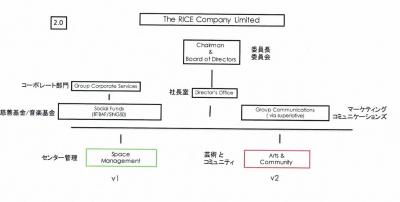
ライスカンパニー組織図 The RICE Company Structure
「リトルアーツアカデミー」
次に、私たちが持っているスペースをご紹介します。まずは、小学生ぐらいのお子さんを対象にしている施設の「リトルアーツアカデミー」です。2005年にBT バディング・アーティスト・ファンド慈善基金を開始し、2008年にリトルアーツアカデミーを設立してから子どもたちの芸術教育プログラムにも基金を当てています。 受益者は経済的に恵まれない家庭の子どもたちです。 支援しているプログラムはダンス、音楽、劇場、ビジュアルアーツなどです。
Now, let me introduce you to our spaces. First one is Little Arts Academy for 6-12 years old. We started our BT Budding Artists Fund in 2005, and the school was set up in 2008, so to provide arts training programs for children. And all children are beneficiallies, coming from financially disadvantaged families. So the programs that we support are dance, music, theatre, visual arts.
―― このアカデミーで教えているのはここの社員なのでしょうか?
Q: Are your staff teaching at this Academy?
コリン:皆プロのアーティストです。プロにお金を支払ってプログラムを教えてもらいます。アーティストも食べていかなくてはいけませんから。
Colin: All artists. We pay professionals to teach the programs. Because artists all need to eat! It is a proper job.
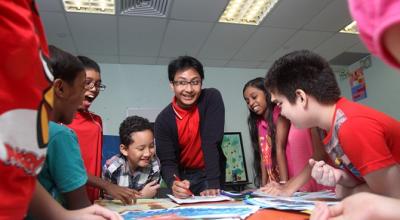
プロのアーティストによる美術の授業 Visual Arts Lesson by a professional artist
ワイイング:私たちの芸術教育プログラムでは、単に勉強するだけではなく、ステージに立って公演をしたり、ライスカンパニーのプロダクションに参加したり、外部のショーに参加したりもします。演劇を勉強している子どもの舞台作品の背景を、美術を勉強している子どもたちが作って、劇場や他のところで発表することもあります。場合によっては海外にも派遣して公演したりもします。
Wai Ying: They don’t just study, but also into stage as well. So they also perform many productions that we have as well. They sometimes go to competitions or outside shows. For instance, the theatrical work of a child who is studying theatre, is collaborated with an art work/props made by a child who is studying visual arts. Sometimes, we also send them abroad to perform.
シンガポール政府の福祉政策と文化政策
コリン:これは政府のルールなのですが、ビルを開発する場合、たとえば福祉目的などで有効に活用する場合には、その分税金が安くなるという仕組みがあります。それと同時に、政府がそれと同じ分のスペースを国のお金で貸してくれます。シンガポールでは福祉施設を作りやすい社会体制になっていて、私たちはそれを利用しているのです。
Colin: For space, there is a government scheme, because property occurs environmental charge, so space they don’t want turns into CSR. When we want to develop a building, if we use it effectively for welfare purposes for example, there is a system that taxes become cheaper correspondingly. At the same time, the government lends the same amount of space with the government money. In Singapore, it is a national policy that makes it easy to create welfare facilities, and we are making a good use of the system.
テン:税制優遇制度ですね。また、ビジネスや建物のオーナーとしてリターンが返ってくるわけです。そしてこれは国の理念でもあり、一緒に協力してやるということなのです。例えば、新しいビルを開発すると税金(development charge)がかかるわけですが、もし福祉事業のための開発だとしたら、これに該当するパーセンテージを換算して、その分の税金控除ができます。場合によっては、年間予算にもよりますが、2倍で控除されます。もうひとつは、例えばこの建物が1000平米だとしますね。これに福祉施設がはいるとなると、さらに免税をアップしていいよとなります。デベロッパーとしては歓迎となるわけです。
Tang: It is a tax incentive system. In addition, good returns come back to business owners and building owners. And this is also the national policy that is to cooperate together. For example, developing a new building will cost tax (development charge), but if it is development for welfare projects, then the government converts the pertinent percentage accordingly, so one will be able to take advantage of this tax incentive. In some cases, depending on the annual budget, it may be doubled. Another thing is that, for instance, this building will be 1000 square meters. When there are some welfare facilities placed into this building, you can further upgrade tax exemption. As a developer, it is a welcoming scheme.
―― シンガポールではまず国がインフラを整備した後で、今は芸術文化に力を入れているとか。国としてのアイデンティティを探っていると聞きました。
Q: In Singapore, the government itself has emphasized on first infrastructure, then now focusing on art and culture. I heard that they are exploring the identity as a country.
「10スクエア」について
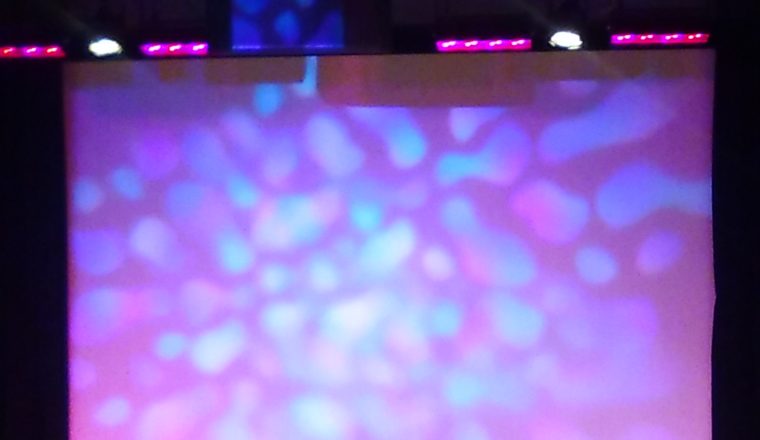
10スクエア内にある110名規模の劇場。もとは駐車場があった場所。
Auditorium at 10 Square, originally a parking lot before the renovation
ワイイング:では次にこのショッピングセンターである「10スクエア」をどのように運営しているかご紹介しますね。この「10スクエア」は年齢が中高生(13-19歳)を対象としています。はじめ、リトル・アーツ・アカデミーを運営していたのですが、教育を受けている子どもたちが段々と年を取っていき、その中学高校生の子どもたちはどうするの?ということになり、その受け皿として作られたものが「10スクエア」です。パビリオンも同じようにして作られました。はじめは何もない人気のないさびしい場所でした。中2階のようなものを周りにつくり、真ん中は吹き抜けのようなものになっており、その吹き抜けのところをステージにしたり展示会会場にして使いながら、周りの部分にはテーブル等がおいてあり、ビジネスをスタートしたい若者たちが利用できるようにしてあります。ワン・ストップ・オフィス・センター のような感じです。これをまねして、中国やベトナムでもこのようなシステムを使ってやろう、という動きもでています。
Wai Ying: Then I will introduce how we operate this Spare 10, a shopping centers. 10 squares runs a art education program for junior and seniors (13-19 years old) . At first we were managing Little Arts Academy, but the children who studied there have gotten older and older, what about the children of the middle -school and high -school age? So that is why Square 10 was created. Pavilion was also created in the same way. At first there was nothing there and it was a deserted place. We made the second floor of the middle around like a colonnade, and we put tables and chairs in the surrounding area while using the place of the colonnade as a stage or as an exhibition hall. It is available for young people who want to start businesses. It’s like a one-stop office center. We are also implementing these ideas in China and Vietnam.
コリン:シンガポール人が中国で所有している土地でそういったことをやろうと考えています。ビジネスを広げようという目的です。中国やシンガポールの投資家の方がこういったビジネスの方法に興味を示してくれて投資してくれています。フィリピンやマレーシアでもやっています。
Colin: In Singaporean-owned lands in China. It is the purpose of expanding business. Investors in China and Singapore are interested in these business methods and approaches, so they are investing to us. We also do it in Philippine and Malaysia.
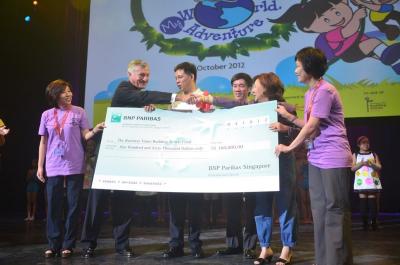
BTバディング・アーティスト・ファンドでの寄付企業
Corporate Donor at BT Budding Artist Fund
ワイイング:私たちの事業の根源・哲学になったものがまさにこの「BT バディング・アーティスト・ファンド慈善基金」のコンセプトにもなっているのですが、生活環境のために芸術文化に触れる機会がないということがどの子にもないように、そしてそれをなくすためにこのような基金が設立されました。また、アートに触れることによって自分たちに自信がつくということもありますし、そういうことによってどんな困難も乗り越えていけるのだという人間の心の部分をつくる助けになればいいなという思いで、こういう基金が立ち上がり運営されています。また2005年の設立から、のべ15,000人の子どもたちに支援しています。
Wai Ying: Though what became the principle and philosophy of our business is exactly the concept of this BT Budding Artist Fun. The fund was established for the purpose of giving every child, with or without any living and financial difficulties, opportunity to experience and learn arts. Also, we believe that this fund can help them become confident, and also help them overcome any difficulties that they may face in the future. Also, since the establishment in 2005, we have been supporting total of 15,000 children.
日本とのパートナーシップ
次に、日本とのパートナーシップですが、交流は10年ぐらいになります。最初のきっかけはスポットライト・シンガポール・イン・ジャパンといってシンガポールを紹介するイベントが日本とシンガポール友好40周年のときに日本で開催されました。
Next, regarding a partnership with Japan, it has been around 10 years. The first opportunity was Spotlight Singapore In Japan, which was an event introducing Singapore as a part of the 40th anniversary of friendship between Japan and Singapore.
このイベントがきっかけで両国で協力してできることがないかと模索し、できたものが恵まれない子どもたちを芸術を使って支援する「チャイルド・エイド・コンサート」といいます。東京では「チャイルド・エイド・アジア」といって、日本のパートナーであるNPO法人リトルクリエーターズと一緒にやっています。子どもが子どもを助けるコンサートです。才能のある子どもたちが舞台公演をし、チケットを売り、その収益がBT バディング・アーティスト・ファンド慈善基金にいき、恵まれない子どもたちを助けるというシステムです。
Because of this event, we started to look for ways to collaborate between two countries, then we decided to do a charity concert called Child Aid Concert. In Japan, it is call Child Aid Asia in partnership with Tokyo’s NPO Little Creators for the purpose of supporting disadvantaged children, which is still going on today. It is a concert that children help children. Talented children perform on stage, sell tickets, and that revenue goes to the BT Budding Artist Fund to help disadvantaged children.
また、この10スクエアを展開するときに、リトルクリエーターズとともにこのハッピー・パンカーキ・カフェを共同で立ち上げることができました。共同経営ではありますが、長谷川さんが日本から寄付をしてくださる方を探し、キッチンは日本からの寄付ですべてまかなわれています。そして、ここであがった収益は子どもたちの支援にまわされています。
Also, when we decided to open Square 10 squares, we could jointly launch this Happy Pancake Cafe, together with Little Creators. Although it is a joint management, Ms. Hasegawa from Little Creators looks for donors from Japan and the kitchen is all covered by donation from Japan. And the revenue raised here is also put in support of children.
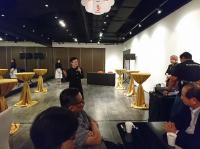
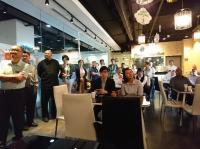
視察当日に行われていた日本のパートナーNPO法人リトルクリエーターズとの共同プロジェクト
‘ハッピー・パンケーキ・カフェ’ 3周年記念セレモニー
The 3yr anniversary ceremony of ‘Happy Pancake Cafe’ with Japanese Partner NPO Little Creators
経済成長とシンガポールの文化的アイデンティティー
―― シンガポールでは急速な経済成長によって都市化現象が急激に進んでいますよね。そういうものは進化すれば進化するほど、シンガポールが持っている伝統的な古い都市構造が失われていっているように感じます。新しくなるのはいいことですが、もともとあったアイデンティティーが失われて子どもたちに異なるかたちで引き継がれてしまいます。また、シンガポールは多民族国家です。さまざまな民族や宗教が混ざっていますね。それに対してどうお考えでしょうか?
Q: In Singapore, we can see the rapid urbanization and economic growth. The more these things evolve, the more I feel that the traditional old city structure of Singapore has been lost. I feel that the culture that Singapore has is also lost. It is a good thing to be new, but the identity that was originally existed would be lost, and is passed on differently to next generation. In addition, Singapore is a multiracial country. Various ethnic groups and religions are mixed. What do you think about it?
コリン:おっしゃったとおりです。建国してから過去50年、シンガポールとは何か、というアイデンティティーを探る私たちの旅だったと思います。タマセク財団というものがあります。シンガポールにある財団ですが、この財団はシンガポールの伝統を守る活動を支援しています。おっしゃるとおり、伝統文化やシンガポールの古きよきというものを守っていくことももちろん重要ですが、最近はシンガポールだけではなくこの地域、アセアン地域の伝統文化を守ることも重要だと感じています。
Collin: You’re right. After building the country for the past 50 years, I think that our journey has been to explore the identity of what Singapore is. There is a thing called the Tamasek Foundation. Although it is a foundation in Singapore, this foundation supports activities to protect and preserve the traditions of Singapore. As you said, protecting traditional culture and old-fashioned things of Singapore is of course important, but recently I feel that it is important not only to protect Singaporean traditions but also the traditional culture of this region, ASEAN region.
シンガポール企業との関係
―― ライスカンパニーの活動ですが、シンガポール企業と協力して何かやっているということはありますか?
Q: Do you have any activities in partnership with or in collaboration with private sectors?
コリン:シンガポールでは有数の土地開発会社サンパワというのがあります。彼らが、何か芸術に関わるアイデアがないかと聞きにきました。通常であれば、こういったことはコンサルタント会社にいくのですが、私たちのような芸術団体に相談にきたのです。それをきっかけに私たちの団体をコンサルタントのように活用してくれているのですが、今ベトナムにある彼らの土地開発場所でデジタルセンターを作るような企画を提案していて進んでいます。その中で劇場やギャラリーなどもその場所に作り、アーティストの雇用につなげることもできるのです。実際、多くの企業がアーティストやアートコミュニティにアイディアを提供するよう求めています。何か特別な劇場を建てると、建物の価値があがります。ここは文化的にすばらしいとか芸術的に美しいとか。そうすることで企業にも利益を還元できると考えています。また、企業のコンサルタントをすることから生まれる利益を、アーティストを支援することに還元しています。
Colin: There is Sunpower Group Ltd., one of the leading land development companies in Singapore. They came to us asking if there was any idea related to art. Normally, they would go to a consultancy company, but they came to consult with an art group like us. As a result, they are utilizing our organization like a consultant, and we are proceeding with proposals that will make digital centers at their land development site in Vietnam now. Among them, we can also make theaters and galleries in that place, which can lead to the employment of artists. Indeed, nowadays many corporations are relying on artists and art communities to provide ideas. Building something special such as building a theater, means that the value of the building rises, getting a good critics like ‘this place is culturally wonderful or artistically beautiful’. We believe that we can return profits to corporations as well. In addition, we are returning profits arising from doing business consulting to supporting artists.
―― シンガポールにはメセナ協議会のような中間支援組織的なものはないのでしょうか?
Q: Is there no intermediate support organization in Singapore like Association for Corporate Support of the Arts?
コリン:ありません。
Colin: No, there isn’t.
―― ライスカンパニーがそのような役割を果たされてはいかがですか? そうすればこちらも一緒に情報交換などでき、アセアンとのプラットフォームもつくれますね。ライスカンパニーはすごく魅力的で、日本にとってもお手本になりそうですね。今日はありがとうございました。
Q: Why should the Rice Company do it? If you do so, we can exchange information together, and we can make a platform with ASEAN. Your company is very attractive and it seems to be a model for Japan too. Thank you for your time today.
コリン:ありがとうございました。
Colin : Thank you very much.
インタビュー2017年11月8日
Interview held on 8 November 2017
